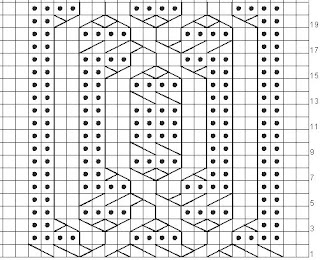So, here is the cable I started with for the collar of my new sweater. I hope the chart and directions make sense!
This is the front( RS) of the cable.
This is the back, or WS. But it might as well be the front side!
In designing this cable, I decided to have all of the crossing action occur on the RS. This makes for a lot of cabling in one row, but ultimately easier to keep track of, since the WS knitting is all "K the Ks and P the Ps" as they appear.
Here is the chart:
And here is the key:
P4F: Move 2 purl sts to cable needle( CN), hold in front, p2, p2 from CN
P4B: Move 2 purls to CN, hold in back, p2 ,p2 from CN
C4F: Move 2 knits to CN, hold in front, work next 2 sts as they appear, k2 from CN
C4B:Move 2 knits to CN, hold in back, work 2 sts as they appear,k2 from CN
And here is the cable pattern in words:
Cable A: on 24 sts
Row 1: (RS) K2,P4F,C4B,P4F,C4B,P4F,K2
Row 2: (WS) P2,K4,p4,k4,p4,k4,p2
Row 3: k2,p2,C4b,c4f,c4b,c4f,p2,k2
Row 4: p2,k2,p2,k4,p4,k4,p2,k2
Row 5:K2,p2,k2,p4b,c4f,p4b,k2,p1,k2
Row 6:P2,k2,p2,k4,p4,k4,p2,k2,p2
Row 7:k2,p2,k2,p2,c4f,c4b,p2,k2,p2,k2
Row 8: p2, k2,p2,k2,p2,k4,p2,k2,p2,k2,p2
Row 9: (k2p2) twice,k2,p4f,(k2,p2) twice,k2
Row 10: (p2,k2( twice,p2, k4, (p2,k2) twice, p2
Row 11: (k2,p2) three times,(p2,k2) three times
Row 12: same as row 10
Row 13: same as row 9
Row 14: same as row 8
Row 15: (k2,p2) twice,C4F, C4B,(p2,k2) twice
Row 16: same as row 4
Row 17: k2,p2,k2,P4B,C4F,P4B,k2,p2,k2
Row 18: same as row 4
Row 19:k2,p2,C4F,C4B,C4F, C4B,p2,k2
Row 20 same as row 2
I find the chart much easier to knit from, as it is a graphic representation.
So, here is the beginning of the sweater, with the collar and the two fronts attached.I'm using two different cable patterns, but the second one is not reversible. Now, back to knitting!
And here is progress up to Row 11 of the yoke:

Meanwhile, I'm still working on my other cabled sweater, having divided for sleeves and now knitting the body:
And here is my friend Linda trying it on from the back:























